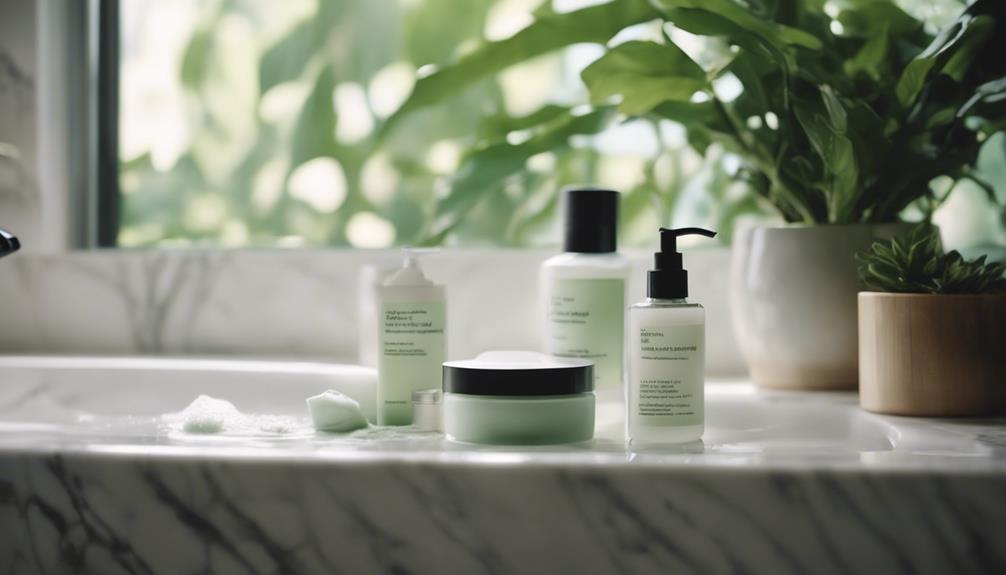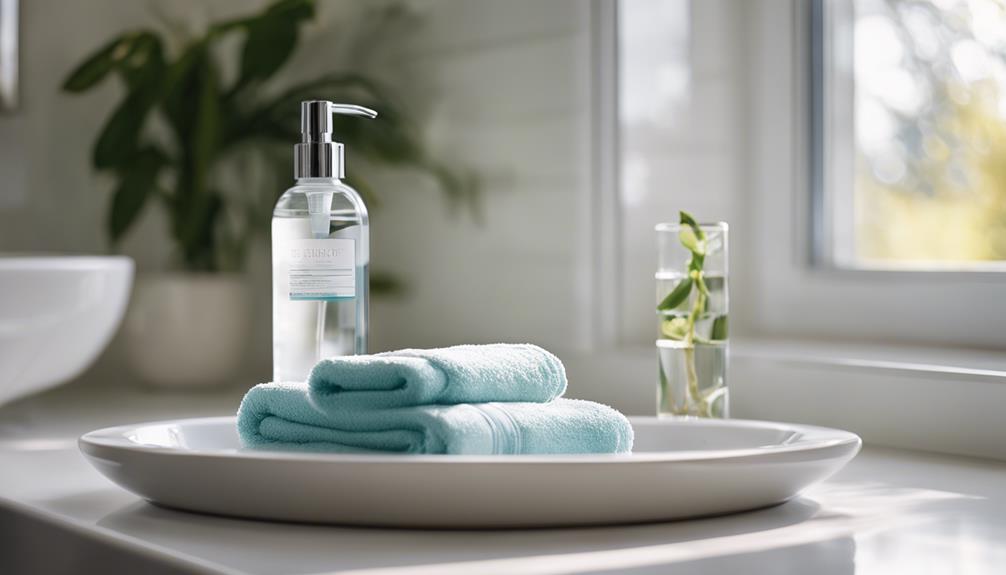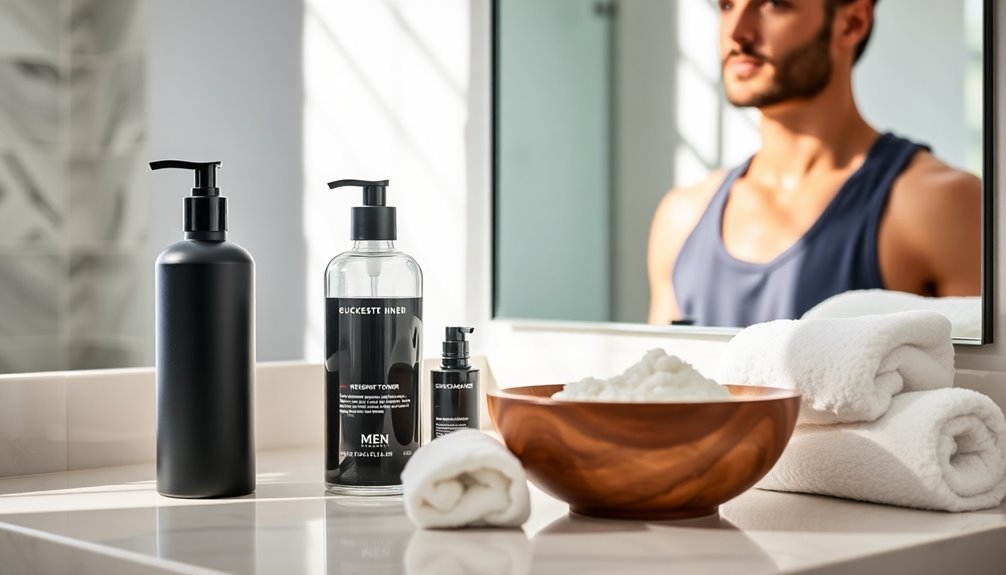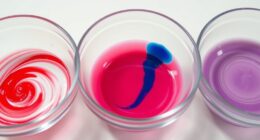To effectively manage oily skin and minimize shine, it is recommended to start with a gentle foaming cleanser that contains salicylic acid. Follow this up with an alcohol-free toner, ideally with niacinamide, to help balance your skin’s pH levels. Make sure to use an oil-free moisturizer to keep your skin hydrated without clogging your pores, and always apply a broad-spectrum sunscreen with SPF 30 during the day. Incorporating gentle exfoliants into your routine 2-3 times a week can help prevent clogged pores, while using clay masks can provide a deep cleanse. Remember to steer clear of heavy moisturizers and alcohol-based products as they can exacerbate oiliness. There is still so much more to learn about optimizing your skincare routine for the best possible results.
Key Takeaways
- Start your morning with a gentle foaming cleanser containing salicylic acid to effectively remove excess oil and impurities.
- Use an alcohol-free toner with niacinamide to balance skin pH and minimize the appearance of pores.
- Apply an oil-free moisturizer with hyaluronic acid for hydration without clogging pores.
- Exfoliate 2-3 times weekly with AHAs/BHAs to prevent clogged pores and promote skin renewal.
Understanding Oily Skin
Oily skin results from excess sebum production, which often gives your complexion a shiny appearance, especially in the T-zone. If you have oily skin types, you might notice that your skin feels greasy shortly after cleansing. This is primarily due to the overactivity of sebaceous glands, leading to an abundance of oil on your skin's surface.
While this excess sebum can make your face shine, it also poses a challenge: you're more likely to experience breakouts. Acne-prone or oily skin tends to clog pores, resulting in comedones like blackheads and whiteheads.
Moreover, while managing oily skin can be tough, there's a silver lining. The increased oil production can help reduce the visibility of fine lines and wrinkles, often giving you a youthful glow. However, factors like genetics, hormonal fluctuations, stress, and humidity can exacerbate the situation.
Understanding these aspects of oily skin not only helps you recognize its characteristics but also prepares you to tackle the challenges that come with it. Embracing an effective skincare routine is essential to keep excess sebum in check and maintain a balanced complexion.
Identifying Oily Skin
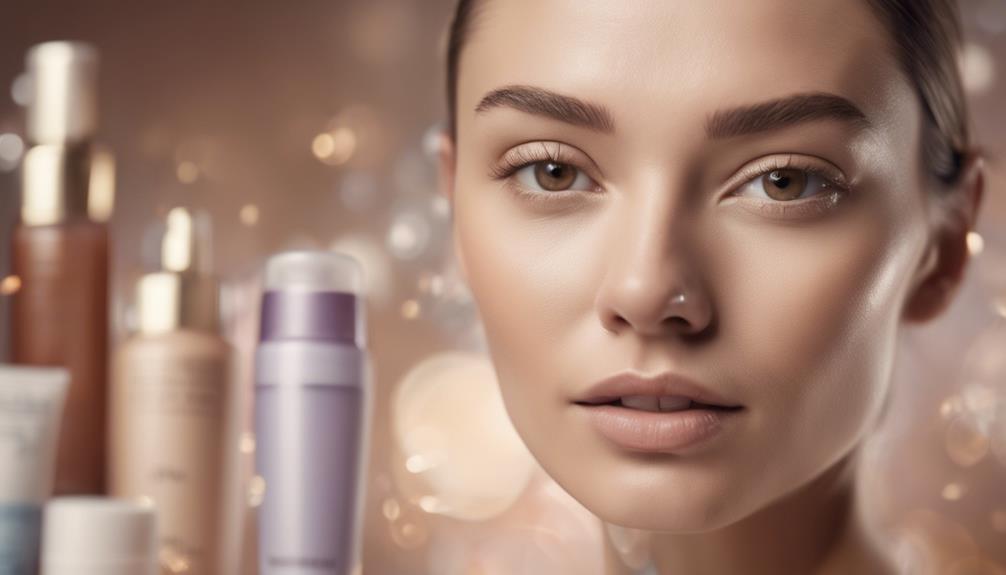
To identify oily skin, you'll want to recognize its key traits, like a shiny appearance, especially in your T-zone.
Pay attention to how your skin feels throughout the day; if it gets oily within 30 minutes of cleansing, that's a strong indicator.
For a more accurate assessment, consider consulting a dermatologist who can offer tailored advice based on your skin type.
Recognizing Oily Skin Traits
If your skin often feels slick and looks shiny, especially in the T-zone, you might be dealing with oily skin. This condition is marked by excess sebum production, leading to a greasy feel shortly after cleansing. You may also notice that your pores appear larger, and you're more prone to breakouts, particularly comedonal acne, which includes blackheads and whiteheads due to clogged pores.
Here's a quick reference table to help you identify oily skin traits:
| Trait | Description | Key Indicators |
|---|---|---|
| Appearance | Slick, shiny skin, especially in the T-zone | Oily look across forehead, nose, chin |
| Feel | Greasy sensation shortly after cleansing | Oily feel within 30 minutes |
| Acne Proneness | Higher likelihood of blackheads and whiteheads | Frequent breakouts in the T-zone |
Recognizing these traits can help you better understand your skin type. If you identify with these characteristics, it's important to establish a skincare routine tailored specifically for oily skin, addressing its unique needs effectively.
Key Observation Techniques
Identifying oily skin involves observing specific characteristics and using simple techniques to assess your skin's behavior throughout the day. One of the first things you'll notice is a slick appearance, particularly in the T-zone, which includes your forehead, nose, and chin. This shine is a hallmark of oily skin.
After using a cleanser, pay attention to how your skin feels. If it becomes oily or greasy within 30 minutes, that's a strong indicator of excess sebum production. You should also monitor for comedonal acne; the presence of blackheads and whiteheads is more common in oily skin types.
A straightforward self-assessment technique involves pressing a tissue against various areas of your face. If it picks up oil, you likely have oily skin. These observations are essential for managing your skincare routine effectively.
Professional Assessment Importance
A professional assessment by a board-certified dermatologist is essential for accurately identifying oily skin and distinguishing it from similar skin types. You might think you know your skin, but a dermatologist's expertise can make a significant difference. They use various techniques and tools to evaluate your unique skin condition, leading to personalized recommendations tailored just for you.
Here's what a professional assessment can help with:
- Evaluating Skin Type: Identifying whether your skin is truly oily or a combination.
- Addressing Concerns: Targeting specific issues like acne and enlarged pores.
- Product Selection: Recommending products that suit your skin's specific needs.
Regular consultations with a dermatologist can transform your skincare routine, ensuring it evolves with your skin's changing needs. By understanding your skin better, you'll not only manage shine effectively but also promote a clearer, healthier complexion.
Don't underestimate the value of a professional assessment—your skin will thank you!
Key Ingredients for Oily Skin
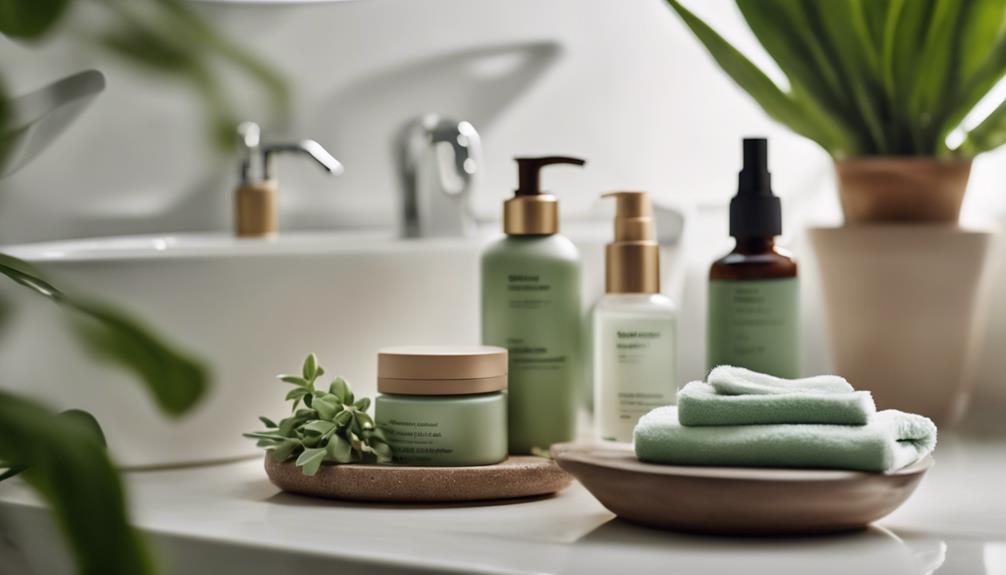
When tackling oily skin, incorporating the right key ingredients can make all the difference in achieving a balanced and clear complexion.
Start with salicylic acid, a beta hydroxy acid that penetrates pores to dissolve oil and combat acne. It's particularly effective for preventing breakouts and controlling excess sebum production, helping maintain a shine-free appearance.
Next, consider niacinamide, which regulates oil production and reduces inflammation. It also strengthens your skin's barrier function, promoting an overall balanced complexion. This ingredient not only keeps oiliness in check but also soothes irritated skin.
Don't forget about hyaluronic acid. While it's essential for hydration, it won't add oil to your skin. Instead, it draws moisture into the skin, ensuring that even oily types stay hydrated without feeling greasy. This balance is vital for healthy skin.
Incorporating these key ingredients into your skincare routine can greatly improve your skin's texture and appearance. You'll find that managing oily skin isn't just about reducing shine but also about maintaining hydration and overall skin health.
Daily Skincare Routine
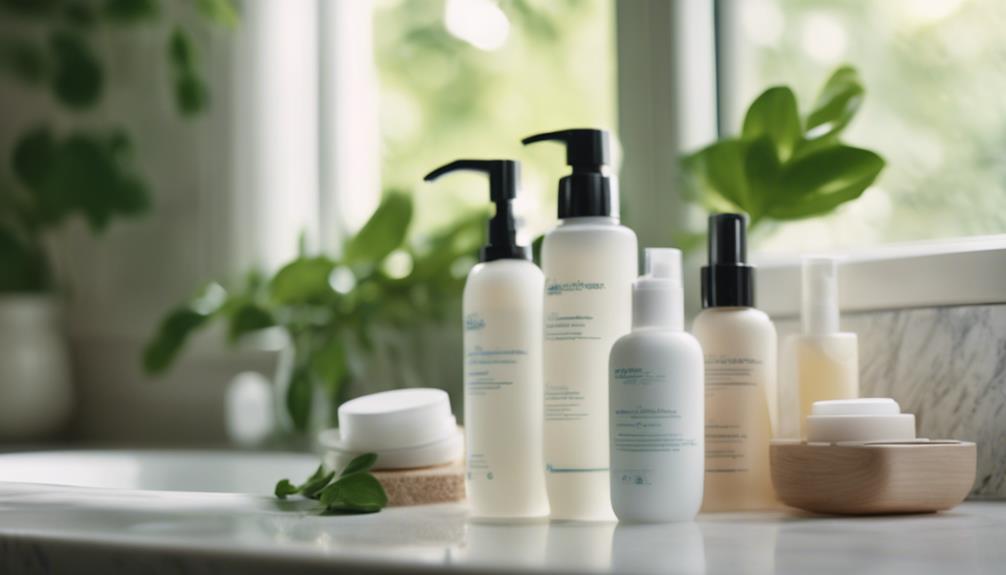
To keep your oily skin in check, establishing a daily skincare routine is essential.
Start your mornings with a gentle foaming cleanser and follow up with a toner, moisturizer, and sunscreen to protect your skin.
In the evenings, focus on treatment steps that target excess oil and prevent breakouts, ensuring your skin stays clear and balanced.
Morning Cleansing Essentials
Starting your morning with a gentle foaming gel cleanser sets the stage for a balanced skincare routine that effectively tackles oily skin.
Look for a cleanser containing 2% salicylic acid to remove excess oil and impurities without over-drying your skin. After cleansing, apply an alcohol-free toner to help restore your skin's pH balance and tighten those pores.
Here's a quick checklist for your morning routine:
- Gentle Cleanser: Choose one that effectively cleanses without stripping moisture.
- Toner: An alcohol-free option will refresh your skin and minimize shine.
- Oil-Free Moisturizer: Make sure you hydrate without clogging pores or adding extra shine.
Being consistent with these steps is vital. By sticking to this routine daily, you'll normalize sebum production and reduce shine over time.
Evening Treatment Steps
Ending your day with a focused evening skincare routine helps remove impurities and prepares your skin for overnight recovery.
Start by cleansing your face with a gentle, foaming gel cleanser that contains salicylic acid. This will effectively remove makeup, dirt, and excess oil accumulated throughout the day.
Next, apply an alcohol-free toner enriched with witch hazel or niacinamide to help restore your skin's pH and minimize the appearance of pores. This step is essential for prepping your skin for the next treatments.
Incorporate a gentle exfoliant into your routine 2-3 times a week, using a chemical exfoliant with AHAs or BHAs to slough off dead skin cells and prevent clogged pores.
After toning, apply a targeted treatment serum that contains retinol or niacinamide. This helps promote skin renewal overnight, reducing oiliness and breakouts.
Finally, finish with a lightweight, oil-free moisturizer, like CeraVe PM Facial Moisturizing Lotion, to hydrate your skin without clogging pores.
Following these steps consistently will guarantee your skin remains balanced, refreshed, and ready to face the next day.
Nighttime Skincare Routine
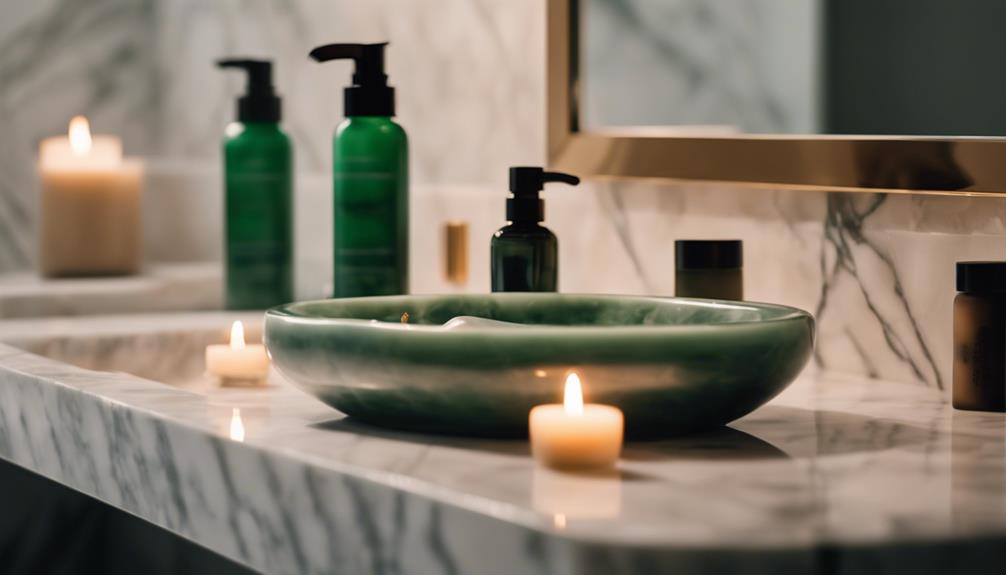
Before heading to bed, make certain to cleanse your skin thoroughly to remove oil and impurities from the day. A gentle, non-drying cleanser, like CeraVe Foaming Facial Cleanser, will prep your skin for the rest of your nighttime skincare routine.
Here's a streamlined approach to guarantee your skin stays balanced overnight:
- Exfoliate 2-3 times a week with gentle acids, such as Paula's Choice 2% BHA Exfoliant, to slough off dead skin cells and prevent clogged pores.
- Apply a retinol product, like Skinbetter AlphaRet Overnight Cream, to promote skin renewal and regulate oil production.
- Moisturize with a lightweight, non-comedogenic moisturizer, such as CeraVe PM Facial Moisturizing Lotion, to lock in hydration without clogging your pores.
Following this routine will help manage shine and keep your skin looking fresh and healthy each morning. Remember, consistency is key for achieving your skincare goals!
Additional Treatments
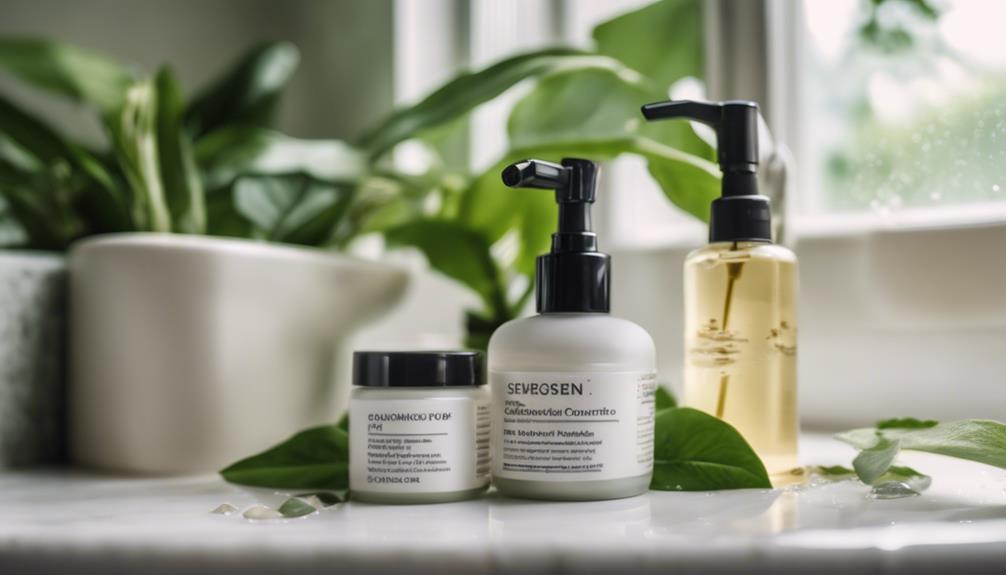
Incorporating additional treatments into your skincare routine can markedly enhance your efforts to manage oily skin and maintain a balanced complexion.
Start by using exfoliating scrubs or treatments containing salicylic acid 2-3 times a week. These help prevent clogged pores and effectively reduce shine.
Next, consider adding clay masks to your routine 1-2 times weekly. These masks absorb excess oil and purify your pores, leaving your skin feeling refreshed and less oily. They're particularly great for controlling shine throughout the week.
For those pesky localized breakouts, spot treatments are your best friend. Look for products with benzoyl peroxide or tea tree oil to target these areas directly. Applying these treatments can help reduce inflammation and speed up healing time.
Additionally, think about incorporating chemical peels with AHAs or BHAs occasionally. These promote deeper exfoliation and can greatly improve your skin texture over time.
Finally, don't forget to use hydrating masks occasionally. Keeping your skin moisturized helps prevent it from overcompensating and producing even more oil.
With these additional treatments, you'll be well on your way to achieving a balanced complexion.
What to Avoid
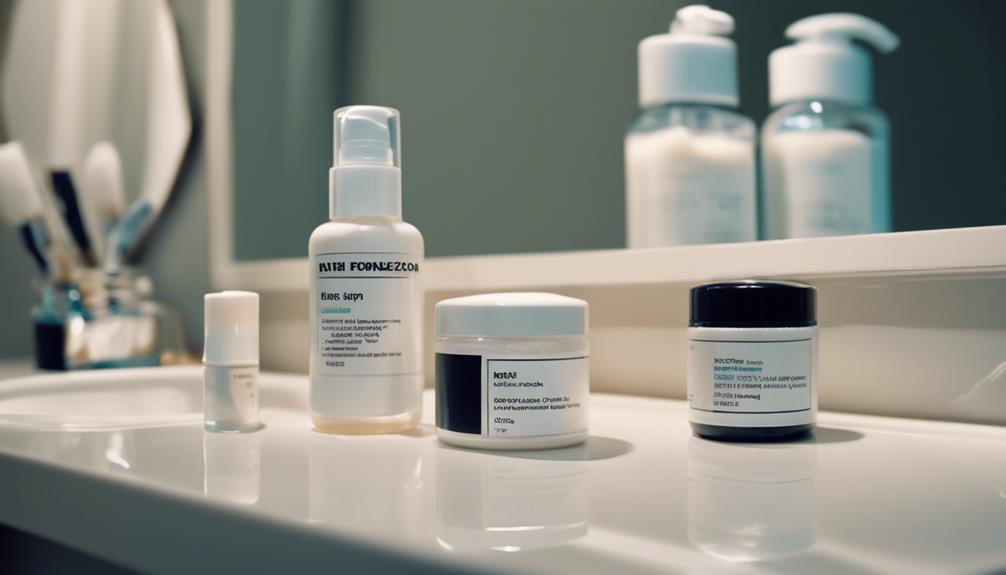
When managing oily skin, it's essential to steer clear of heavy moisturizers like those with cocoa butter or lanolin, as they can clog your pores.
You should also watch out for comedogenic ingredients, which can lead to breakouts and worsen oiliness.
Heavy Moisturizers Risks
Many heavy moisturizers can clog pores and worsen oily skin, so it's important to choose your products wisely. When you opt for thick, oil-based formulas, you risk overwhelming your skin's natural oil production. This can lead to increased shine and breakouts, making your skincare routine counterproductive.
To avoid the pitfalls of heavy moisturizers, keep an eye out for these key factors:
- Oil-based ingredients: Ingredients like cocoa butter or lanolin can clog pores.
- Non-comedogenic options: Look for products labeled as non-comedogenic to help prevent acne.
- Alcohol content: Avoid alcohol-based formulas that can over-dry your skin, causing it to produce even more oil.
Comedogenic Ingredients Impact
Certain comedogenic ingredients can wreak havoc on your oily skin, leading to clogged pores and breakouts if you're not careful. To maintain a clear complexion, it's vital to steer clear of products that contain these pore-clogging offenders. Always look for 'non-comedogenic' labels, as these products are designed to prevent pore blockage.
Here's a quick reference table to help identify common comedogenic ingredients you should avoid:
| Ingredient | Comedogenic Rating | Alternatives |
|---|---|---|
| Cocoa Butter | 4 | Aloe Vera, Jojoba Oil |
| Lanolin | 4 | Squalane |
| Coconut Oil | 4 | Grapeseed Oil |
| Silicones | 3 | Water-based formulas |
| Fragrance | 3 | Unscented products |
Using products with these ingredients can lead to excessive oiliness and unwanted breakouts. Instead, focus on lightweight, non-comedogenic alternatives that maintain your skin's balance without blocking your pores. Stay informed and choose wisely to keep your oily skin looking its best!
Expert Recommendations
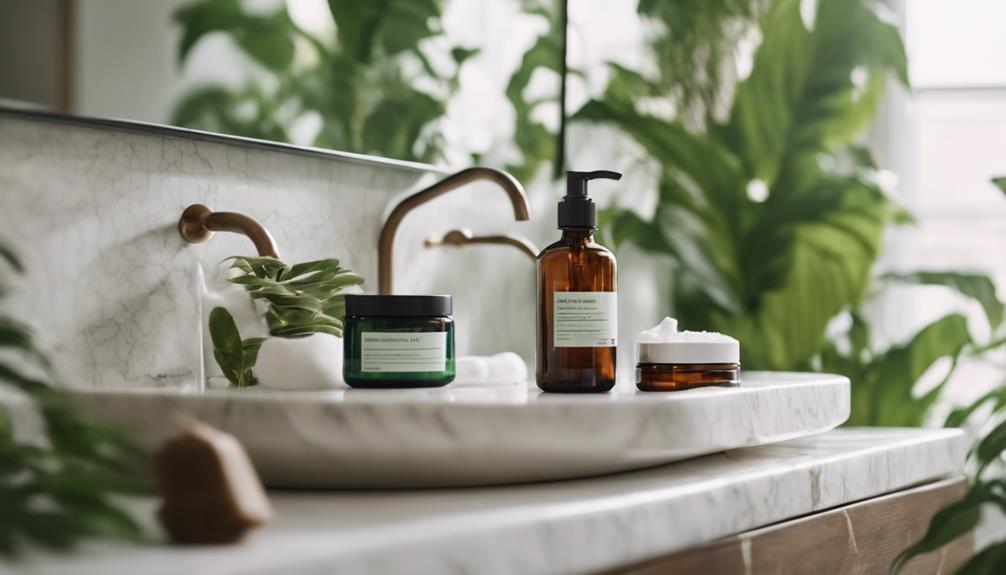
To effectively manage oily skin, dermatologists recommend starting with a gentle, foaming cleanser that contains salicylic acid. This type of cleanser helps remove excess oil without over-drying your skin, which can lead to more oil production.
Next, consider using an alcohol-free toner with niacinamide. This can help balance your skin's pH and minimize the appearance of pores.
Here's a quick checklist for your routine:
- Use a gentle, foaming cleanser with salicylic acid.
- Apply an alcohol-free toner with niacinamide.
- Choose lightweight, oil-free moisturizers that contain hyaluronic acid to maintain hydration without clogging pores.
Lastly, don't forget about sunscreen! Daily application of broad-spectrum, oil-free sunscreen is essential for protecting your skin from UV damage while managing oiliness.
Recommended Products
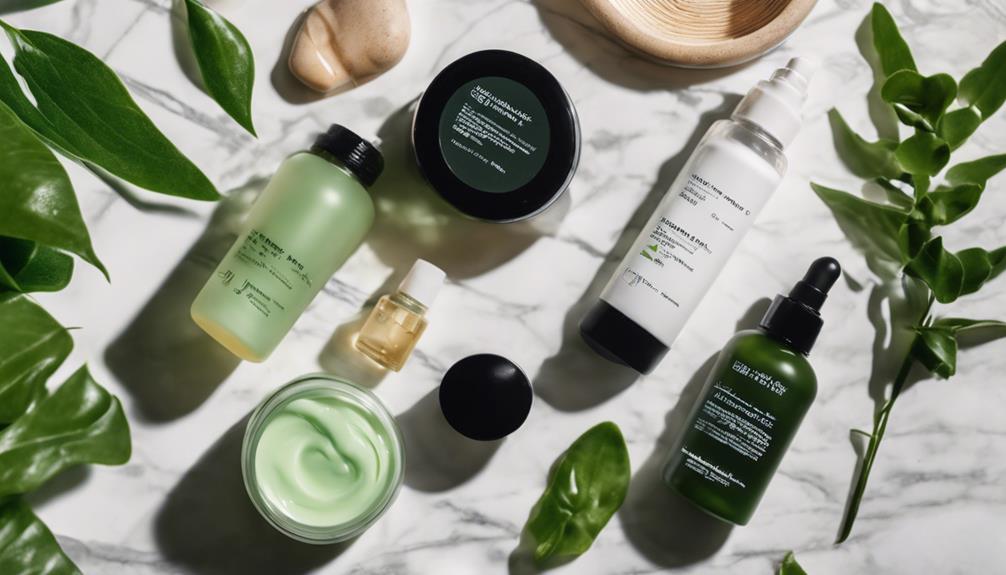
When it comes to managing oily skin, selecting the right products can make a significant difference in achieving a balanced complexion.
For your daily cleansing routine, consider the CeraVe Foaming Facial Cleanser. It contains niacinamide and hyaluronic acid to cleanse effectively without stripping moisture, all for about $19 for 12 oz.
Next, the Murad Clarifying Toner is a great option to balance your skin and reduce sebum production. Priced at $30 for 6 oz, it features witch hazel and grape seed extract for excellent oil control.
To further enhance your skincare for oily skin, incorporate The Ordinary Niacinamide 10% + Zinc 1% serum. This affordable serum, costing just $6 for 1 oz, effectively reduces breakouts and helps promote oil control.
For nighttime rejuvenation, the Skinbetter AlphaRet Overnight Cream is a recommended retinol product that minimizes pores and reduces oiliness, priced at around $125.
Related Resources
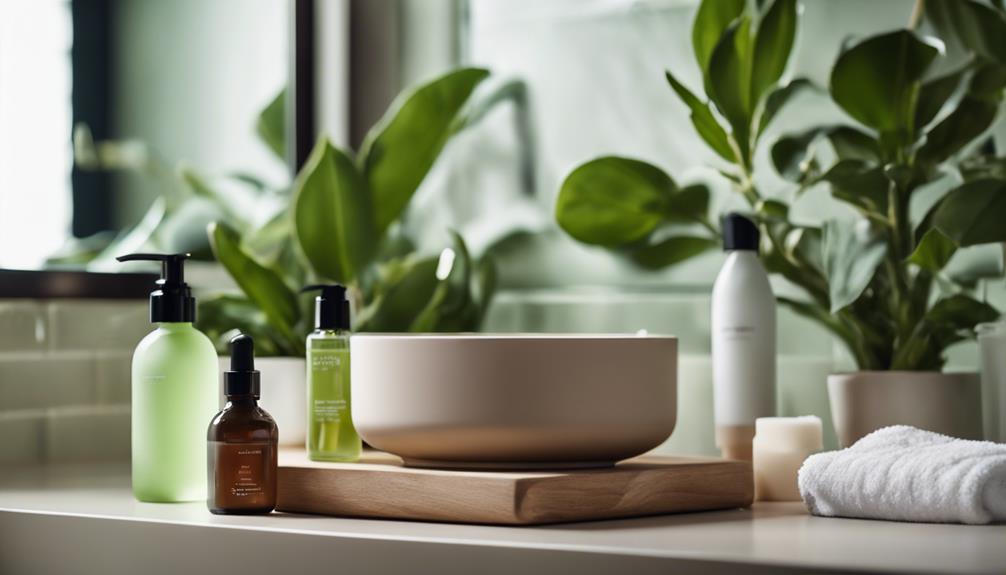
Exploring additional resources can enhance your oily skin skincare routine and help you achieve a clearer complexion. By incorporating effective strategies and products, you can better manage shine while ensuring your skin remains hydrated and healthy. Here are some valuable resources to take into account:
- DIY Masks: Try homemade masks with ingredients like honey and clay to absorb excess oil and clarify your skin.
- Cleansers: Look for low-pH cleansers containing salicylic acid, as they balance oily skin and prevent breakouts.
- Makeup Wipes: Choose sensitive skin-friendly makeup removers to eliminate excess oil without causing irritation.
Additionally, explore natural remedies for acne management, like tea tree oil and green tea extracts, which can effectively help control breakouts.
Is the Skincare Routine for Oily Skin Different from Regular Skincare?
Yes, the skincare routine for oily skin is indeed different from regular skincare. To manage oily skincare routine, it’s important to use products specifically designed for oily skin, such as oil-free cleansers and lightweight, non-comedogenic moisturizers. Additionally, incorporating exfoliation and clay masks can help control excess oil production.
Conclusion
To sum up, managing oily skin doesn't have to be a struggle. With the right routine and products, you can effectively control shine and achieve a healthy complexion.
Did you know that nearly 40% of adults experience oily skin at some point in their lives? This statistic highlights that you're not alone in this journey.
By understanding your skin and sticking to your routine, you can embrace your natural beauty with confidence.
